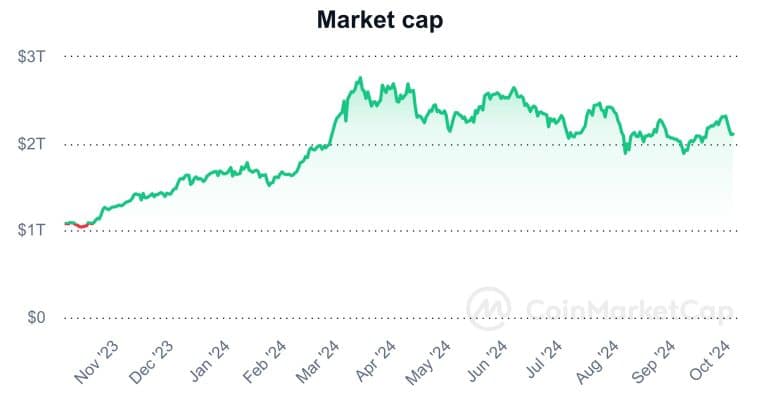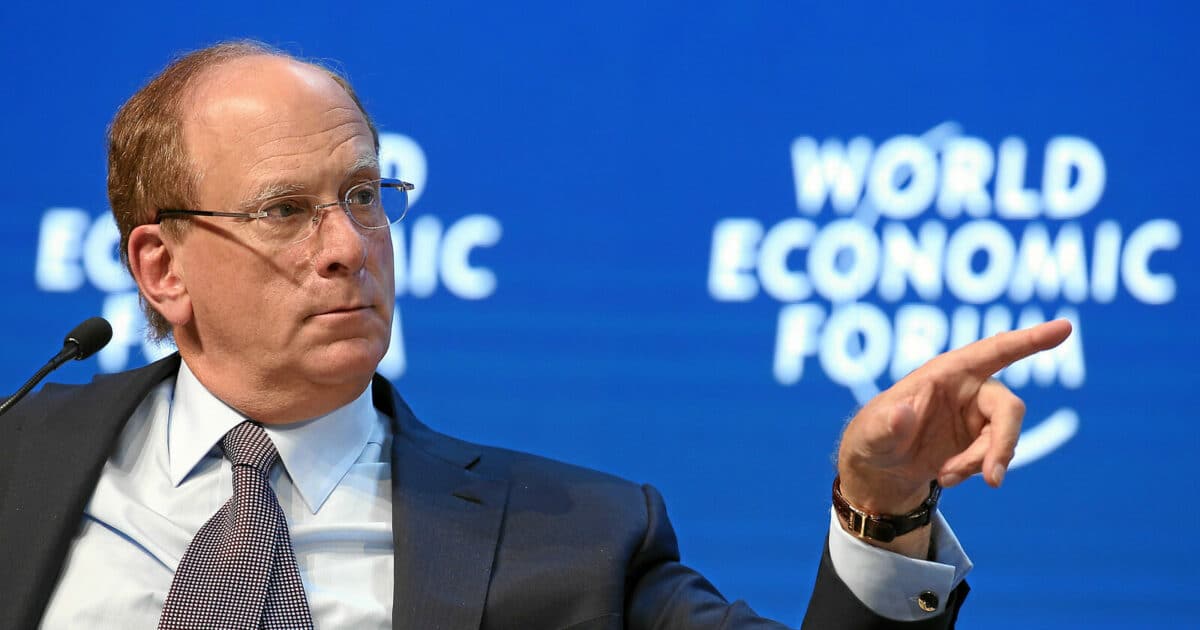The head of the world’s largest asset management firm, BlackRock, has made some interesting comments lately about the potential consequences of the Federal Reserve’s decision to cut its benchmark interest rate by 50 basis points. He warned the cryptocurrency community that they perhaps shouldn’t be so pollyannaish about the rate’s effects on crypto prices.
In a conference in Berlin, Fink highlighted that the level of monetary easing that the market is anticipating is just unrealistic.
“I do believe there’s room for easing more, but not as much as the forward curve would indicate.”
Market data suggests that investors are pricing a 33% chance that the Fed will slash rates by another 50 basis points during its November meeting and that they will diminish the percentage by another 190 basis points by the end of 2025.
These projections, Fink believes, are too optimistic as the Federal Reserve itself has said that they have no predefined path as to how fast or by how much they will be cutting rates or even if they will keep slashing them in their upcoming meetings.
Also read: Analysts Explain What the 50 BP Rate Cut Means for Crypto
This is a risk to the valuation of cryptocurrencies as any changes in the Fed’s view that put these expectations to the test may result in a significant decline.
Despite Fink’s warnings, other analysts like David Brickell and Chris Mill do believe that the market is poised to enter a bullish cycle as the economic stimulus from China to aid its ailing economy could flood the markets with a “tsunami liquidity.

Brickell, head of international distribution for FRNT Financial, and Mill, a former forex trader, wrote that the combination of the Fed’s action to slash rates and China’s economic stimulus are crucial variables that will result in a global easing cycle.
“They say don’t fight the Fed. Also don’t fight China. Definitely don’t fight the Fed and China together,” the two analysts emphasized.
Morgan Stanley Sees Bitcoin Rising to Fresh All-Time Highs in 12 to 18 Months
Meanwhile, Morgan Stanley has said that the crypto market has entered a post-halving season and they looked at historical patterns to chart what Bitcoin (BTC) could do shortly afterward.
They claim that the most predictable pattern based on historical reactions to the halving will be a gradual ascent followed by a sharp rise to all-time highs. Then, there will be a stage of intense speculation and froth that will end with a crypto winter.
Morgan Stanley analysts outline a scenario where Bitcoin could rally to its highest levels on record (the current all-time high is $73,750) for 12 or 18 months after halving – meaning that the bullish cycle could end somewhere near April and October 2025.
Another Wall Street titan, the investment firm Bernstein, has provided a specific price target for BTC, suggesting that it could reach $200,000 by 2025.
Cathie Woods Maintains $1 Million by 2030 Target for BTC
Historical data analyzed by Cathie Wood of Ark Invest indicates that Bitcoin may suffer sustained declines of 77% or more following such peaks.
Wood has been one of the most vocal Bitcoin bulls in the financial indufinkstry. In a recent interview with the New Zealand Herald, Wood reiterated and even strengthened her firm’s bullish outlook on Bitcoin.
“Our target is above that; it’s well above that, and with our new expectations for institutional involvement, the incremental price that we assume for institutions actually has more than doubled,” Wood stated, referring to Ark’s previous $1 million by 2030 projection.
Wood emphasized that the recent approval of spot Bitcoin ETFs by the SEC has been a “major milestone” that has accelerated their timeline for Bitcoin’s price appreciation.
She noted that major financial institutions like Morgan Stanley, Merrill Lynch, and Bank of America have not yet approved the addition of Bitcoin to their managed portfolios, which suggests that there is significant untapped potential for institutional adoption down the road. To reach the $1 million mark by 2030, Bitcoin would need to generate annualized returns of approximately 75% or more.
While this may seem ambitious, Wood points out that Bitcoin achieved annualized returns of 230% between 2011 and 2021, suggesting that such growth is not unprecedented in the crypto market.
DMV’s Adoption of Blockchain Tech Signals Increasing Support for The Sector
Billionaire investor Mark Cuban has highlighted a recent development in California as a significant step forward for cryptocurrency adoption.
This is an amazing step forward for crypto.
Unless of course Gary Gensler sues the state because the value of the token representing each car title goes up or down based on the efforts of the state to promote it. https://t.co/oXgeDn8trb
— Mark Cuban (@mcuban) July 31, 2024
The California Department of Motor Vehicles (DMV) has digitized 42 million car titles using blockchain technology, specifically on the Avalanche blockchain. Cuban described this move as “an amazing step forward for crypto” and a “huge” milestone for the industry.
He emphasized the importance of this initiative as it normalizes the use of crypto wallets: “The reason why this is huge for crypto is because the people holding the tokens will have an app with an avalanche wallet,” Cuban stated.
“Tens of millions of Californians having and using a crypto wallet over the next five years, or however long it takes, normalizes the use of wallets and crypto,” he added.
John Wu, president of Avalanche developer Ava Labs, told Reuters that the California DMV is “creating a wallet where you download on your phone.” This integration of blockchain technology into government services could exp0nentially increase public exposure to and familiarity with crypto wallets and blockchain applications.
Cuban also speculated on the broader implications of such initiatives, suggesting that if the US dollar’s status as the global reserve currency were to decline, Bitcoin could potentially become “a ‘safe haven’ globally” and a “global currency.”
The Crypto Market Remains Highly Volatile Despite Growing Adoption Rates
Despite the optimistic outlooks from figures like Wood and Cuban, the cryptocurrency industry still faces significant regulatory challenges. The SEC’s approach to crypto regulation continues to be a subject of heated debate. Cuban jokingly suggested that SEC Chair Gary Gensler might sue California over its blockchain initiative.
Meanwhile, Bitcoin’s price history is marked by extreme volatility and, even as institutional adoption increases, the potential for sharp price swings remains. The cryptocurrency recently experienced a pullback, falling below $54,000 after reaching an all-time high of over $70,000.
While many analysts and industry figures are bullish on Bitcoin’s long-term prospects some investors still see Bitcoin as a speculative bubble with no intrinsic value. The worst-case scenario, although considered unlikely by most experts, would be a complete loss of value for Bitcoin.
Political and regulatory risks also persist, with some politicians viewing cryptocurrencies as a tool that facilitates money laundering and sanctions evasion rather than a legitimate financial innovation.
As Bitcoin and the broader cryptocurrency market continue to mature, opinions on their future remain diverse and often contradictory. While figures like Larry Fink urge caution when it comes to the market’s expectation about the course of the US monetary policy, others like Cathie Wood and Mark Cuban see tremendous potential for growth and adoption.
The integration of blockchain technology into government services, as seen in California, represents a new frontier for crypto adoption. Meanwhile, the cyclical nature of Bitcoin’s price movements, influenced by factors such as halving events and macroeconomic conditions, continues to shape the market’s expectations.
